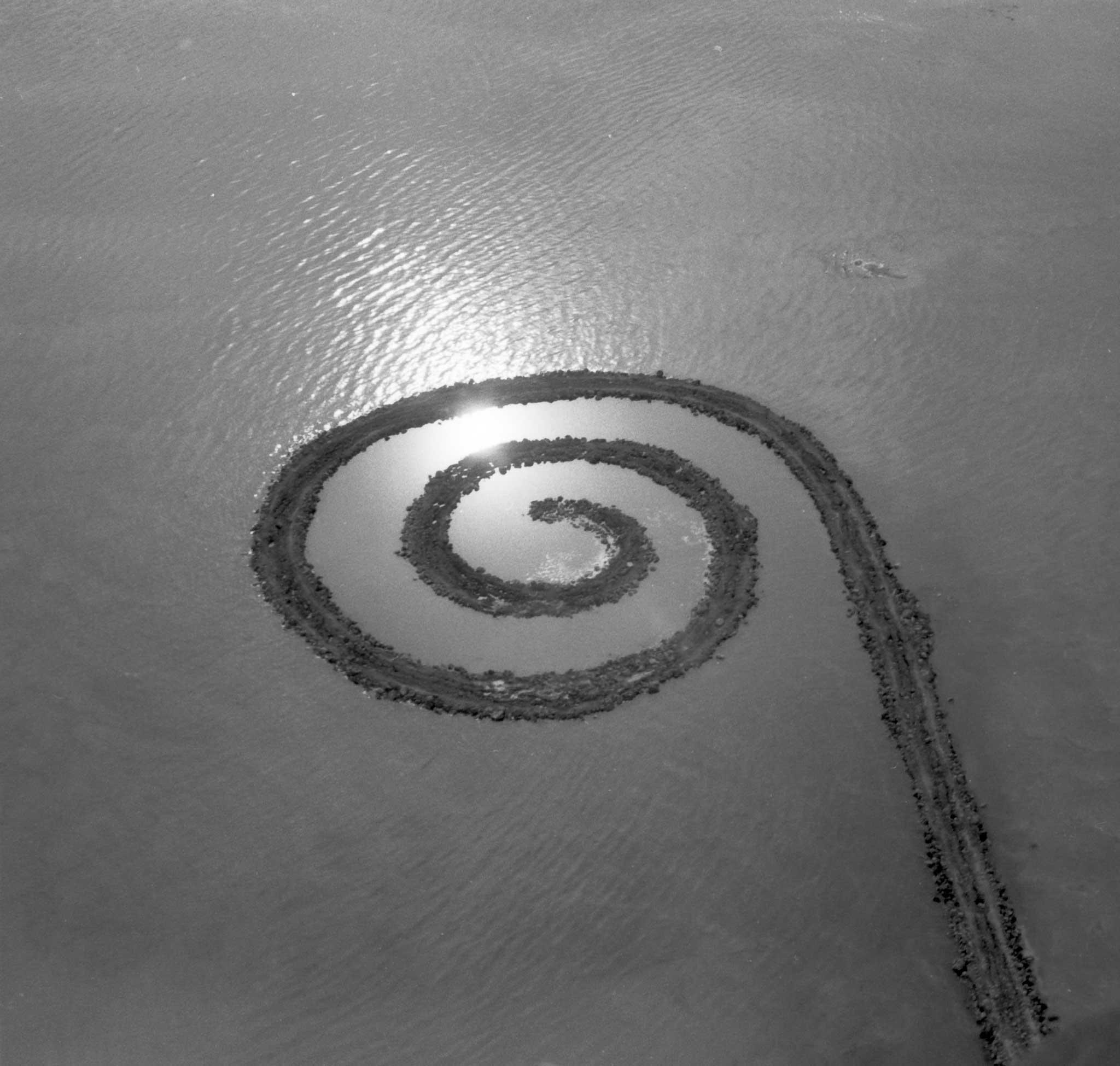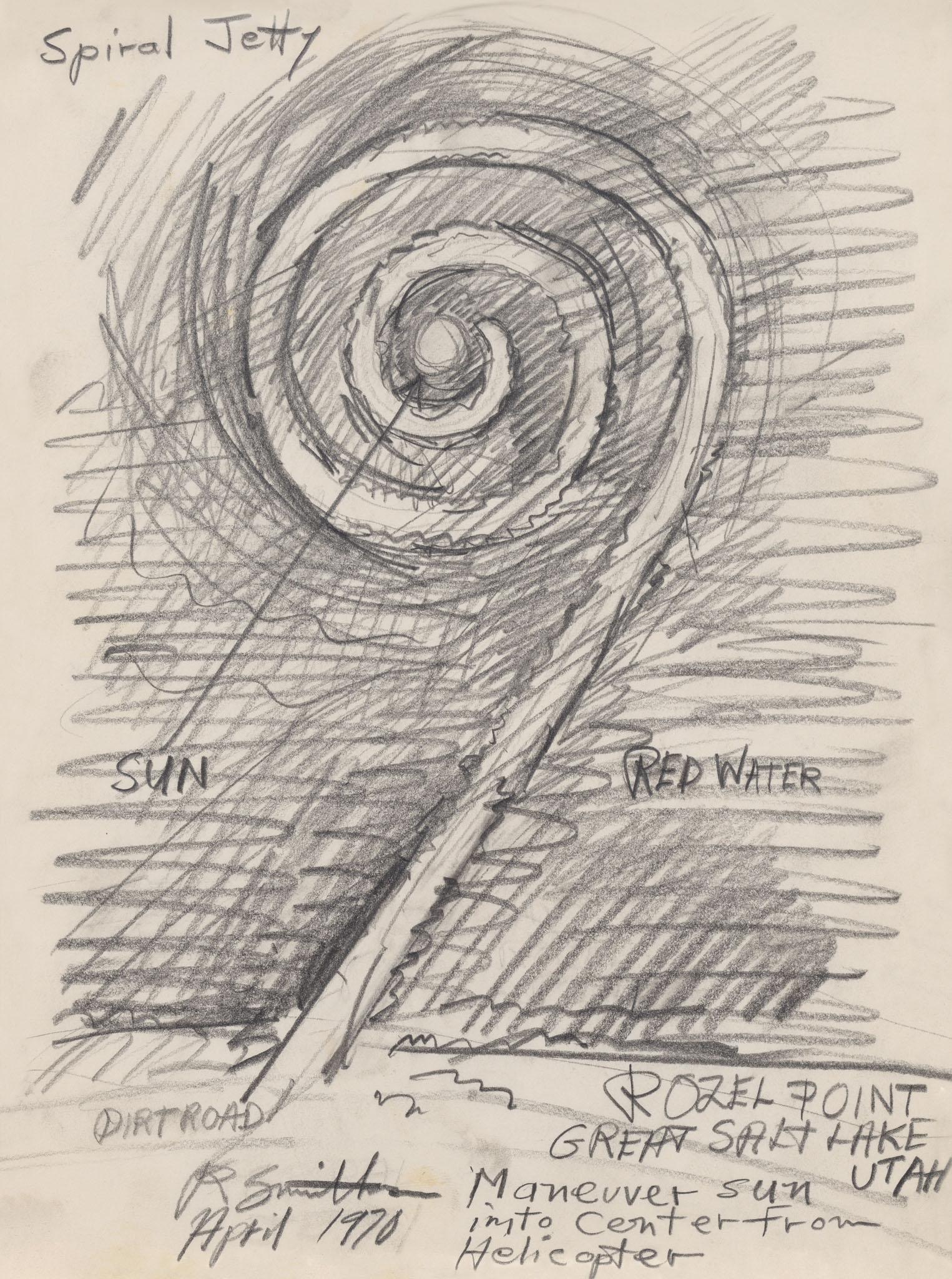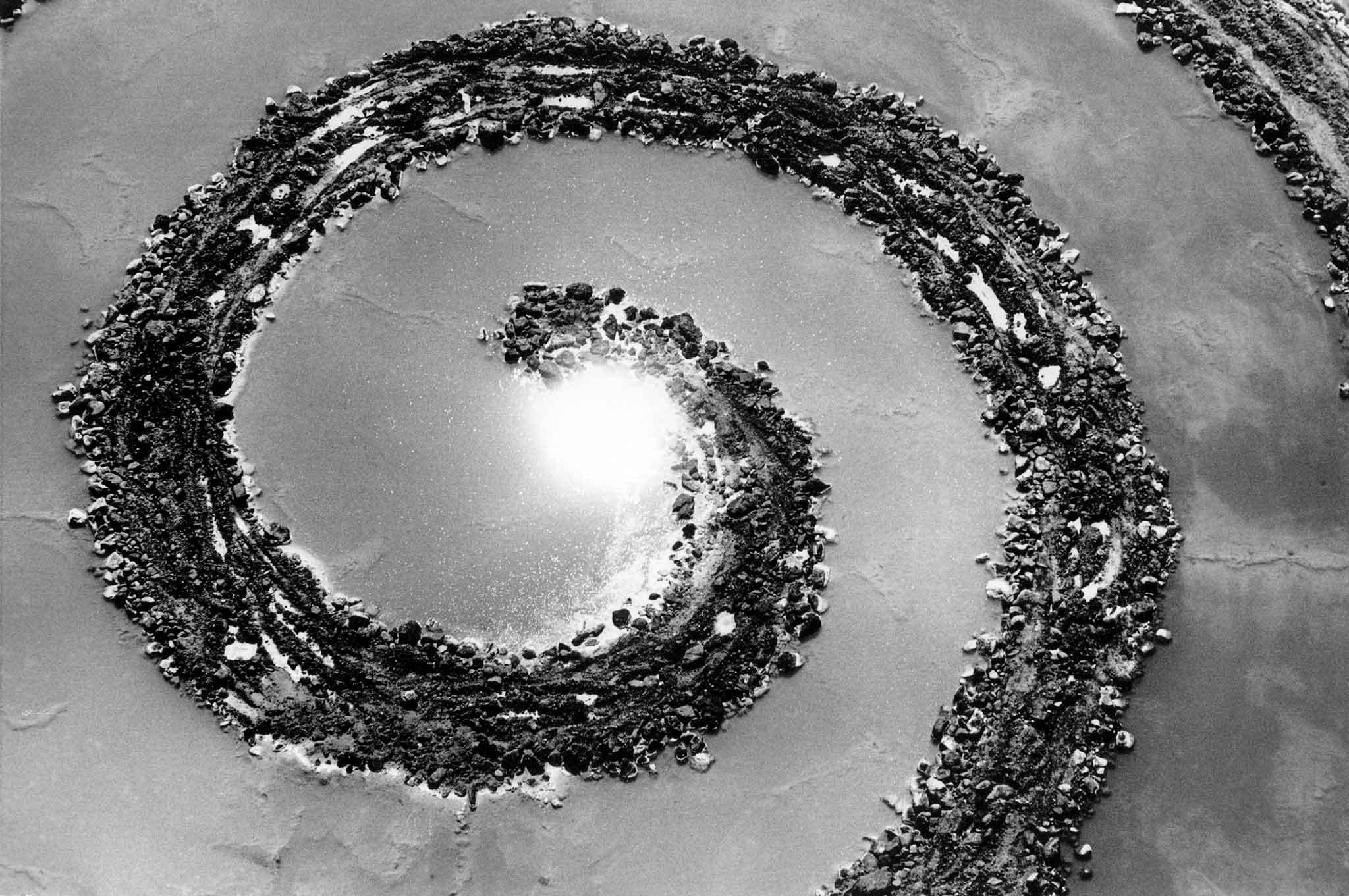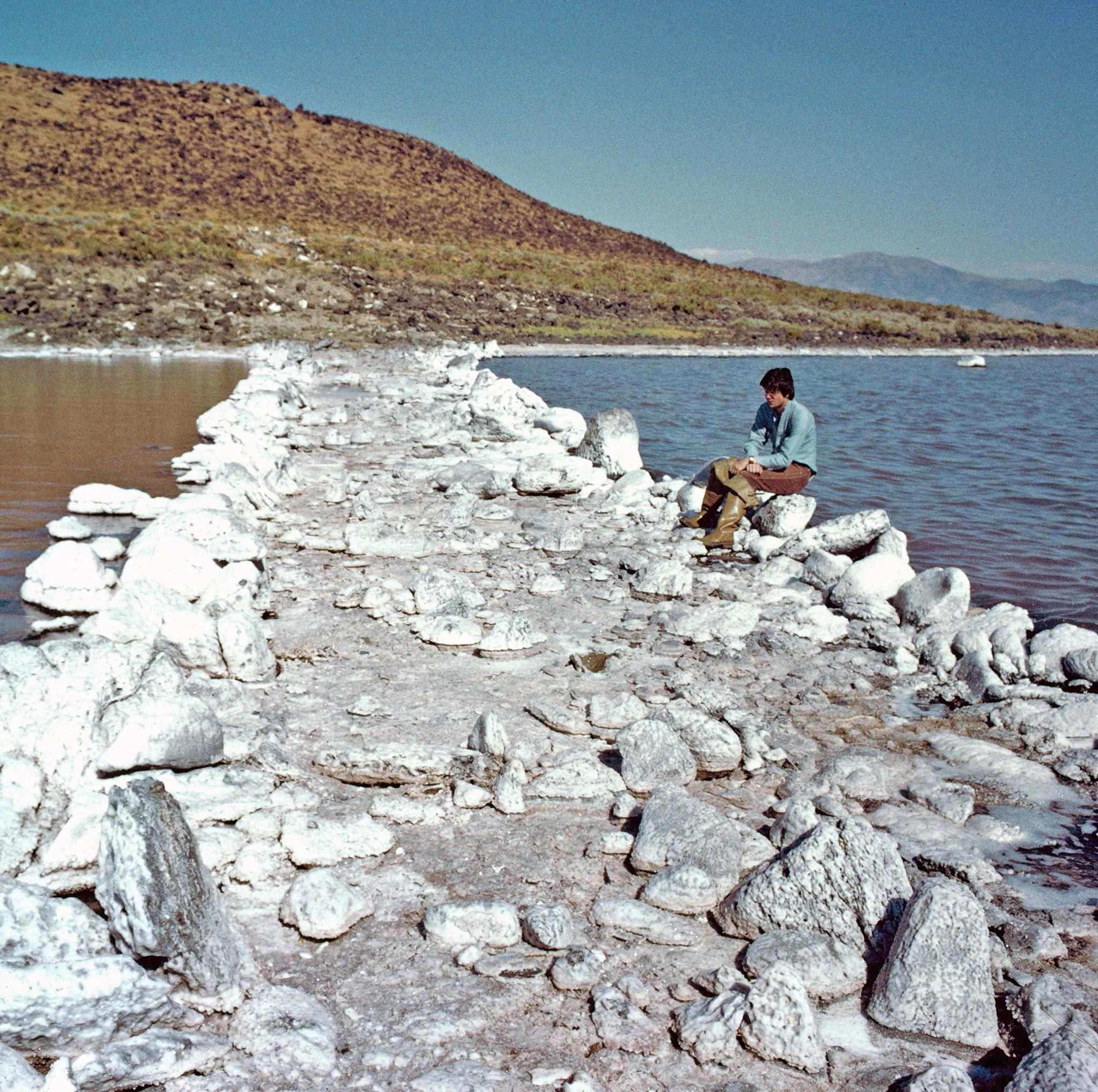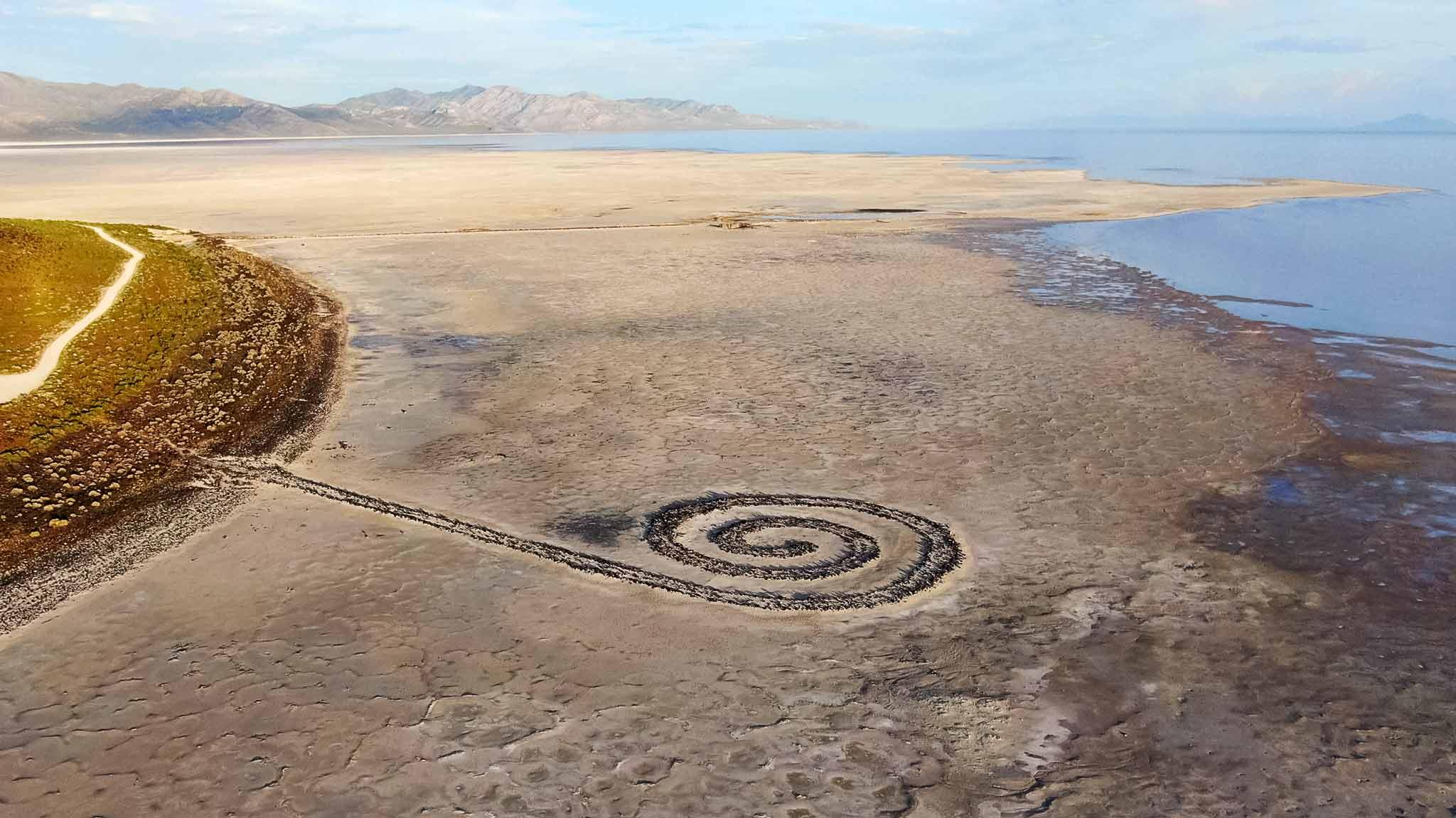Spiral Jetty
Robert Smithson designed and directed the construction of his iconic work the Spiral Jetty in April 1970. The Jetty is a site-specific work, meant to interact with changing conditions of the surrounding water, land, and atmosphere. While located in a relatively barren, unpopulated place, Smithson chose the site not only because of the vast surrounding landscape, but with reference to nearby abandoned oil rigs and the Golden Spike monument marking the 1869 completion of the transcontinental railway. He understood these as industrial ruins, or entropic residues.1 The artist's essay "The Spiral Jetty" and the eponymous film he made with Nancy Holt, can be considered as coordinate "non-site" aspects of the artwork. In 2017 Utah designated the Spiral Jetty as the state's official work of art.
Smithson's planning and design of the Spiral Jetty, like a number of his earthworks, involved a developing process, drawing on a number of factors. These included the physical site itself in its geological, geographical, and ecological complexity. For example, the basalt rock comprising much of the Jetty is the product of extinct volcanoes. From an early age, Smithson was an enthusiastic student of geological history, whose radical breaks and upheavals he saw inscribed in such materials.2 Crystal formation, as he pointed out, follows a spiral pattern that he noted in many natural processes.3 Originally Smithson was attracted to the Rozel Point location because of its abundance of salt crystals and the red algae which proliferated in that section of the Great Salt Lake.
Smithson directed the building of the Jetty, working with a local contractor, Robert "Bob" Phillips. Although Phillips had no previous involvement with artistic work, his knowledge of local materials and experience building dikes in the Great Salt Lake was indispensable.4 Heavy earth moving machinery, which can be seen in the photographic and film records, was used to move 6,650 tons of material.5 Smithson considered several possibilities for construction at the site, including an island. He thought at first that the Jetty was finished in a form that was not fully spiral, but shaped like a hook with a small circle at its end. After considering this for a few days, he insisted that the contractor redo the construction to produce the shape that is now iconic. With some persuasion (and additional payments) the work was done. Finally the Jetty was a full spiral.
Smithson was a cerebral artist whose ideas of entropy, monumentality, and the history of art inform his work. The Jetty's form suggests similarities with archaic earthworks, such as Native American serpentine mounds (Ohio) or the Nazca lines (Peru).6 However, it differs from such putative predecessors by being built into the water. Those earlier works exist in the form of ruins whose purpose and meaning are now obscure. The Jetty, on the other hand, is the work of an individual rather than a culture, and its author provided intensive accounts of its meaning (see entries on the associated article and film). Another significant difference has to do with the work's temporality. Whereas the archaic works were presumably meant to be durable monuments, the Jetty already suggests and anticipates its own ruin. Smithson was fascinated by the form of the ruined monument. From early on he showed an interest in pyramidal ziggurat forms, constructing both glass versions (e.g. Mirror Strata 1966-69), drawings, and cardboard spiral models.7 He referred several times to the Biblical motif of the Tower of Babel and its association with the disintegration of a single language into a multiplicity of words and tongues.8 The Jetty can be seen as a flattened Tower of Babel. In an earlier essay, a somewhat parodic take on the monumental genre, he spoke of buildings that "don't fall into ruin after they are built but rather rise into ruin before they are built."9 In January 1970, Smithson established Partially Buried Woodshed as a deliberately constructed ruin on the Kent State University campus (Ohio). Smithson's concern with ruins is related to his interest in entropy. According to physical theory, the overall organization of any closed system can only decrease over time. This is illustrated by irreversible changes such as scrambling an egg (it can't be unscrambled) or mixing two differently colored batches of sand in a sandbox (Smithson's example). On this view of time, things can only run down, a tendency suggested perhaps by the Jetty's counter-clockwise orientation (seen from shore). Smithson cited the anthropologist Claude Lévi-Strauss, who adapted the idea to cultures, arguing that the basic structures of social systems inevitably fray and lose their integrity; he playfully renamed his discipline "entropology."10
Although Smithson sometimes criticized the artificiality of "the gardens of history," the Jetty shares at least one characteristic with works like those of the British picturesque: it invites the observer's mobility. As he said in an interview, an important dimension of experiencing the work is walking it in both centripetal and centrifugal directions.11 Of course the dramatic sense of space expanding and contracting in the context of vast horizons stands in sharp contrast with the casual picturesque stroll. In contrast to what he called "gardens of history" the Spiral Jetty can be considered as a "site of time."12 One of Smithson's relevant inspirations is a film he admired, Chris Marker's La jetée (1964). The protagonist travels back in time from a dystopian postwar future, only to return as the victim to a murder scene he'd witnessed on a linear jetty as a child.13 Several of Smithson's essays of the late 60s explore similar themes which indicate the idea of space and time informing the Jetty. In one the artist describes the work of emerging Minimalist artists as "new monuments" that lead us to "forget the future" rather than remembering the past and have the effect of fragmenting and spatializing time.14
Smithson's insistence on the significance of entropy and his early accidental death (1973) left open a number of questions concerning the work's maintenance and preservation. They can be condensed to this: to what extent should a work that is meant to exhibit the entropic character of both nature and culture be conserved in its original state? Even during his lifetime, the lake's water level had risen to cover the Jetty. Smithson is reported as saying that he intended to build it higher so that it would remain above water, but this was never done.15 The water level continues to fluctuate, so that the Jetty is alternately above, below, or at surface level. Moreover, a number of subtle changes in local conditions eventually led to the disappearance of the red algae, and thus to a changed water color. As both Smithson's essay and film make clear, he saw redness, associated with blood and the fiery sun, as an important aspect of the work. Yet the red coloring is not constant. When the Jetty emerged from the water in 2002 it was encrusted with white salt crystals. Smithson himself initiated a process of closely tying the work to its photographic representations, and these have proliferated, showing the Jetty in diverse colorings and natural settings, including winter scenes in a frozen lake. Clearly, Smithson intended the work to embody a number of themes and topics concerning entropy. If new but related questions have arisen, it is consistent with the idea of entropy that the work should lead to unanticipated consequences. Seen from the shore, the Jetty can suggest the form of a question mark.
Selected Bibliography
Lynne Cooke et. al. eds. Robert Smithson: Spiral Jetty, ed. (New York: Dia Art Foundation; Berkeley, University of California Press, 2005)
Hikmet Sidney Loe, The Spiral Jetty Encyclo (Salt Lake City: The University of Utah Press, 2017)
Jennifer Roberts, Mirror-Travels: Robert Smithson and History (New Haven: Yale University Press, 2004)
Gary Shapiro, Earthwards: Robert Smithson and Art After Babel (Berkeley: University of California Press, 1995)
Robert Smithson, Robert Smithson: The Collected Writings, Jack Flam ed., (Berkeley: University of California Press, 1996)
About the Author
Gary Shapiro is a philosopher who has written on many topics and figures in post-Kantian Continental philosophy and on philosophical approaches to visual art and literature. His book Earthwards: Robert Smithson and Art After Babel (1995) was the first monograph devoted to the artist. Shapiro's other writings include Nietzschean Narratives (1989), Alcyone: Nietzsche on Gifts, Noise, and Women (1991), Archaeologies of Vision: Foucault and Nietzsche on Seeing and Saying (2003), and Nietzsche's Earth: Great Events, Great Politics (2016).
- 1Jennifer Roberts, Mirror-Travels: Robert Smithson and History (New Haven: Yale University Press, 2004) pp. 114-139.
- 2Robert Smithson, "Strata: A Geophotographic Fiction," in Robert Smithson: The Collected Writings, Jack Flam ed., (Berkeley: University of California Press, 1996), pp. 75-77.
- 3Smithson, "Entropy and the New Monuments," in Writings, pp. 20-21.
- 4Bob Phillips, "Building the Jetty," in Robert Smithson: Spiral Jetty, ed. Lynne Cooke et. al. (New York: Dia Art Foundation; Berkeley, University of California Press, 2005), 185-197.
- 5Robert Hobbs, Robert Smithson: Sculpture (Ithaca: Cornell University Press, 1981), p.191.
- 6Lucy Lippard, Overlay: Contemporary Art and the Art of Prehistory (New York: Pantheon Books, 1983).
- 7Gary Shapiro, Earthwards: Robert Smithson and Art After Babel (Berkeley: University of California Press, 1995), plates 36, 37, 38.
- 8Smithson, "Quasi-Infinities and the Waning of Space," in Writings, p. 34; Shapiro, Earthwards, pp. 191-233.
- 9Smithson "A Tour of the Monuments of Passaic, New Jersey," in Writings, p. 72.
- 10Smithson, "'The Earth, Subject to Cataclysms, is a Cruel Master,'" in Writings, pp. 256-257.
- 11Robert Smithson, "Talking with Robert Smithson," interview by Kenneth Baker, in Cooke, p. 158.
- 12Smithson, "A Sedimentation of the Mind: Earth Projects," in Writings, p.105.
- 13Shapiro, Earthwards, p. 242 n. 8.
- 14Smithson, "Entropy and the New Monuments," in Writings, pp. 10-11.
- 15Hobbs, Robert Smithson, p. 197.
Shapiro, Gary. "Spiral Jetty." Holt/Smithson Foundation: Scholarly Texts Chapter 1 (November 2019). https://holtsmithsonfoundation.org/spiral-jetty-0.
